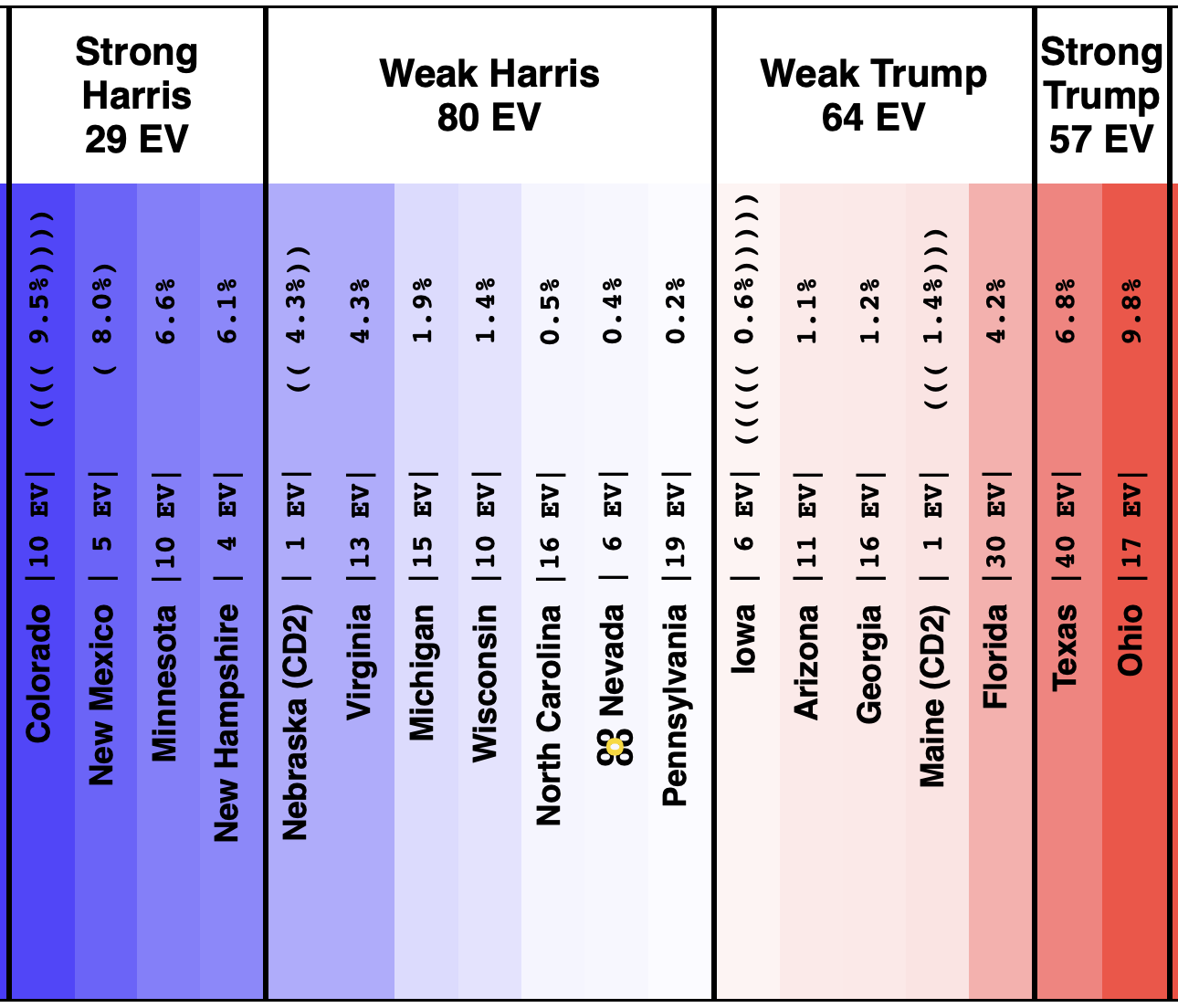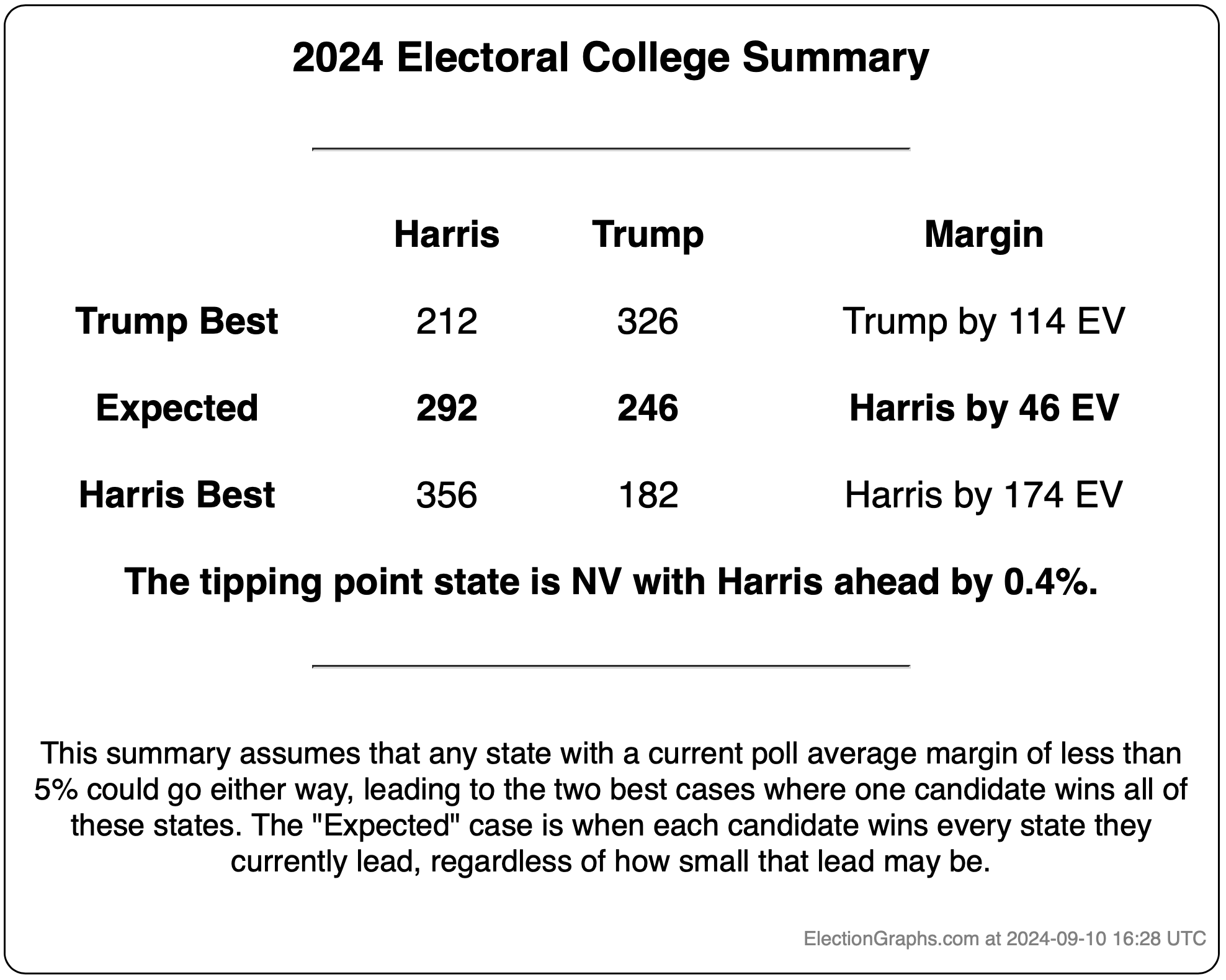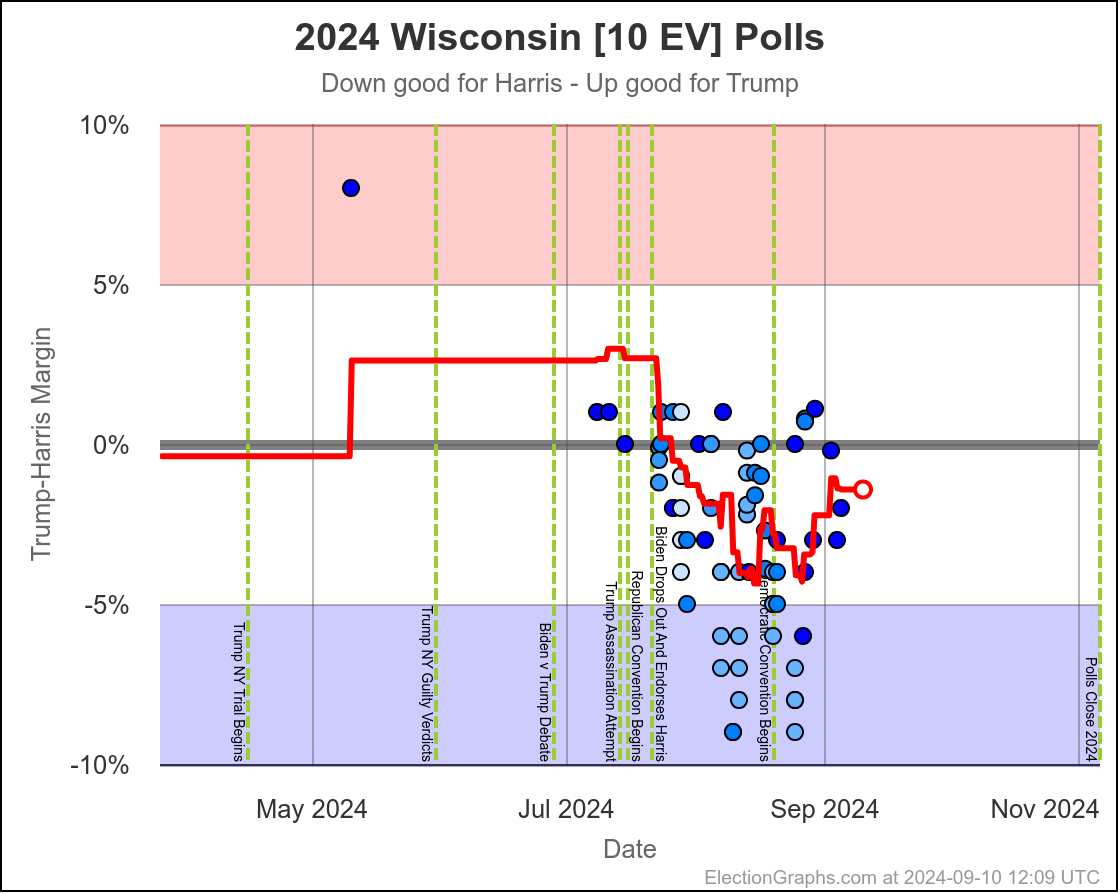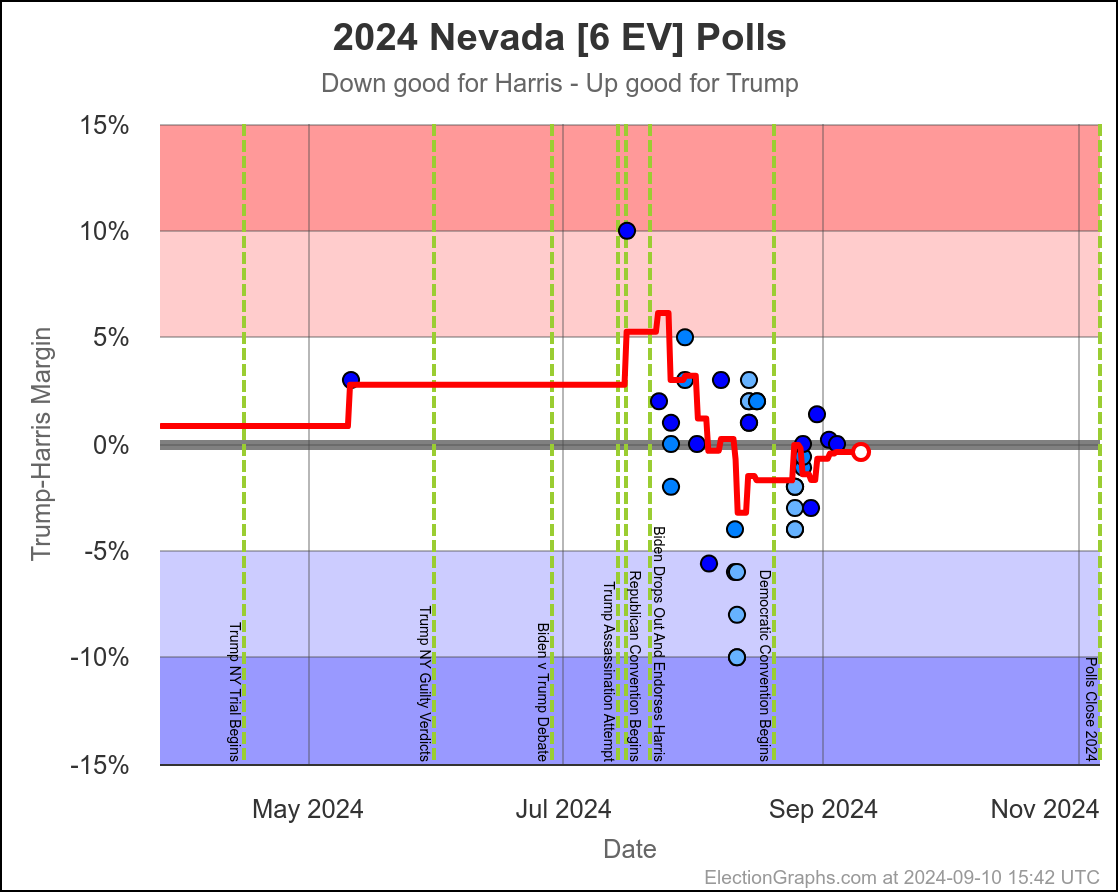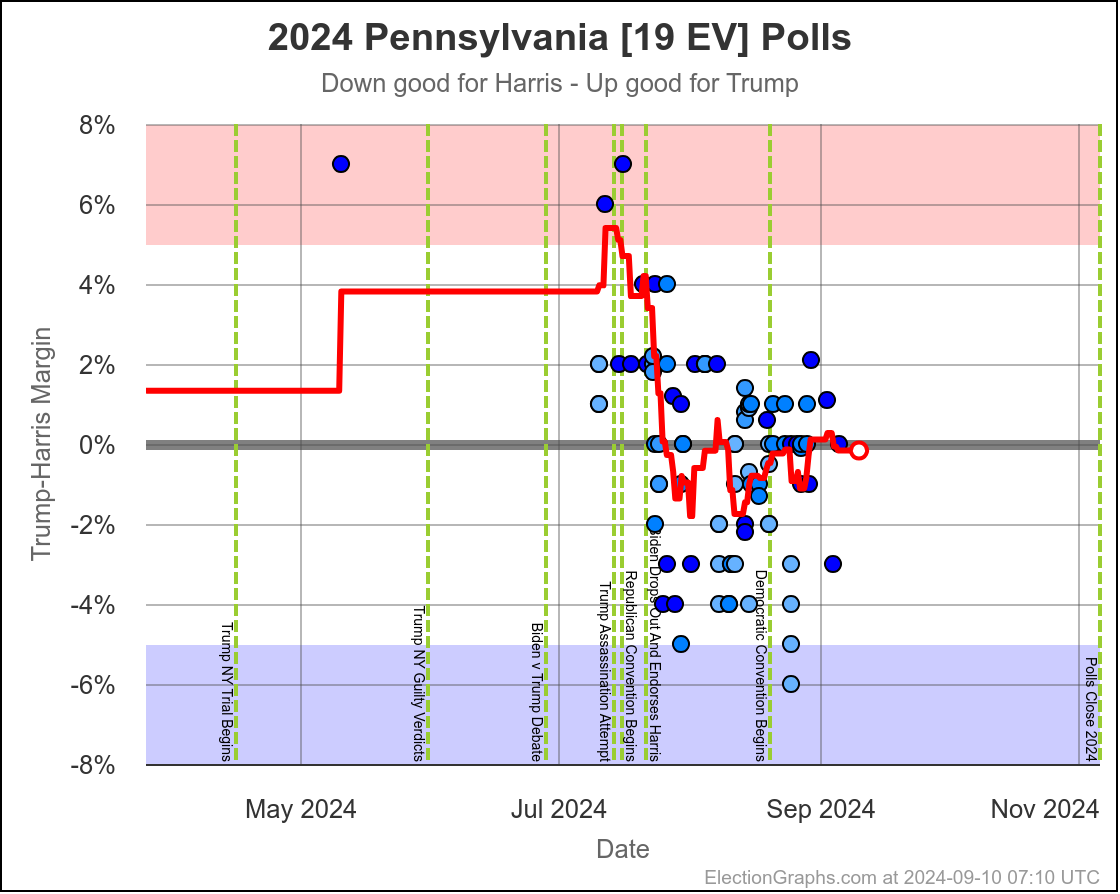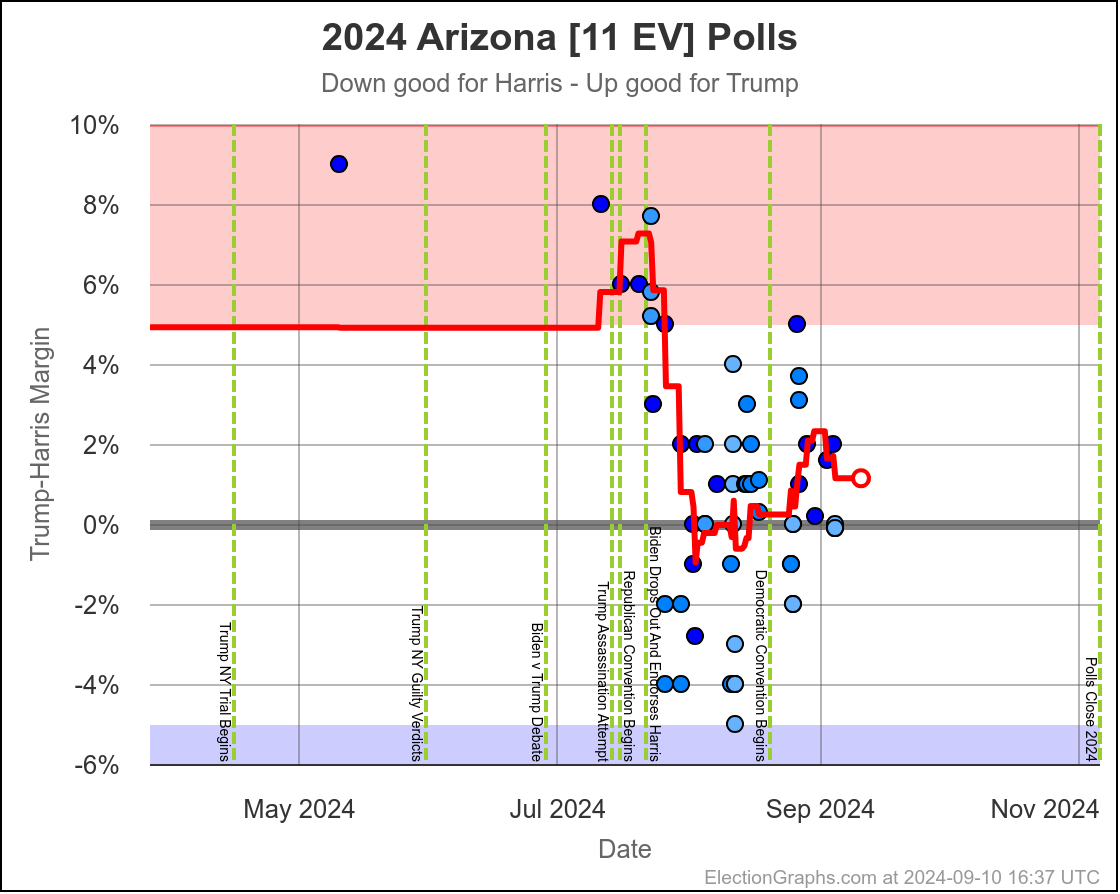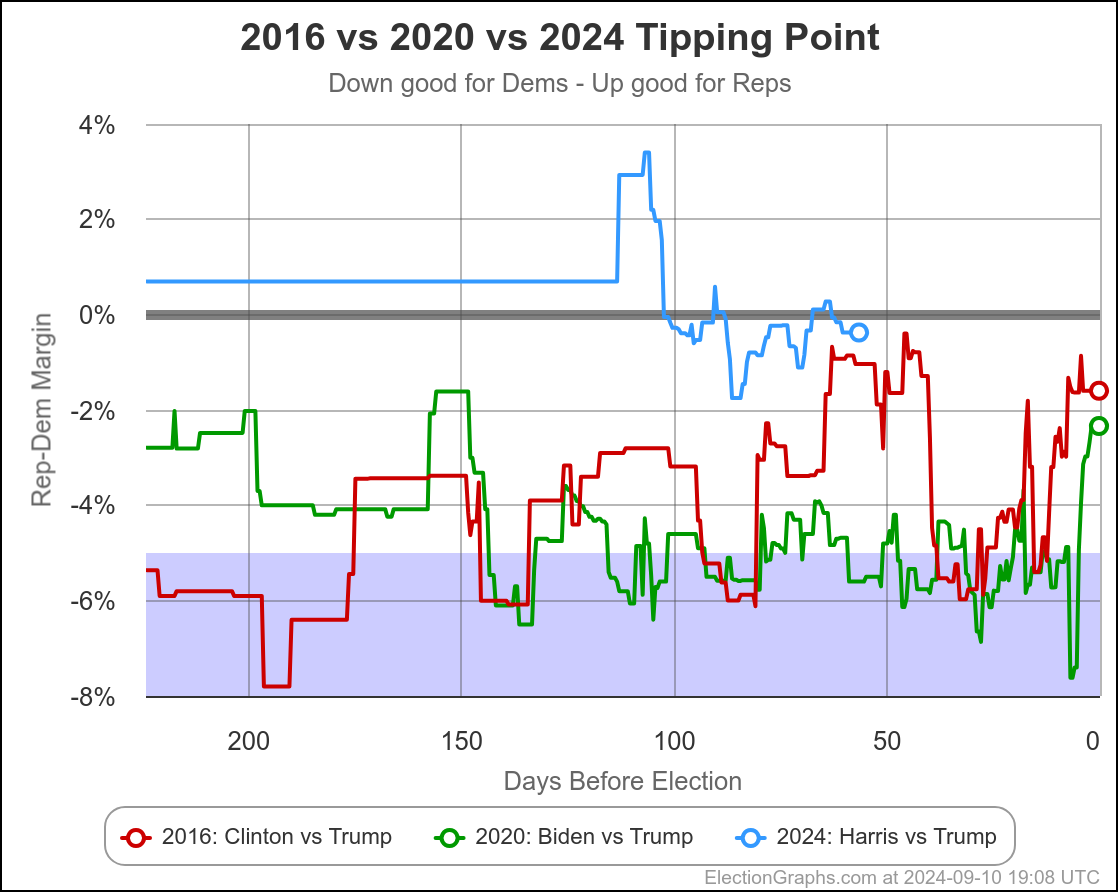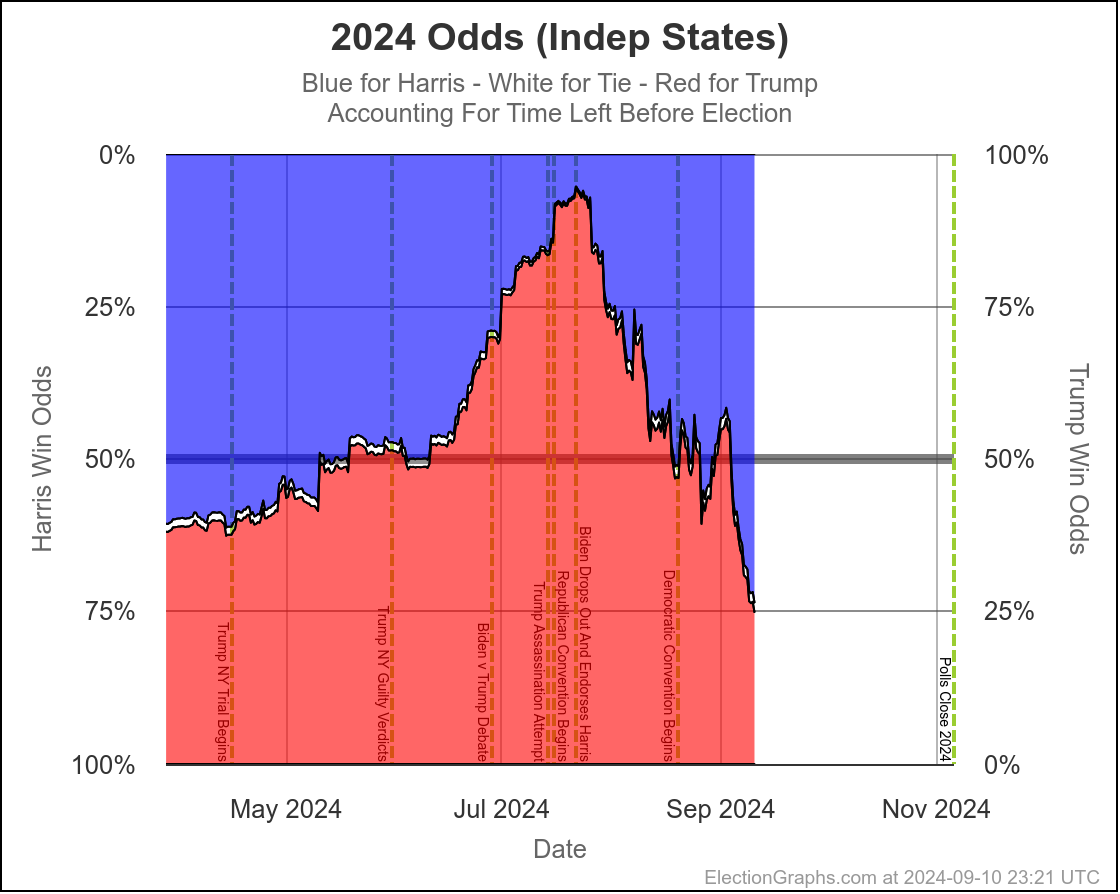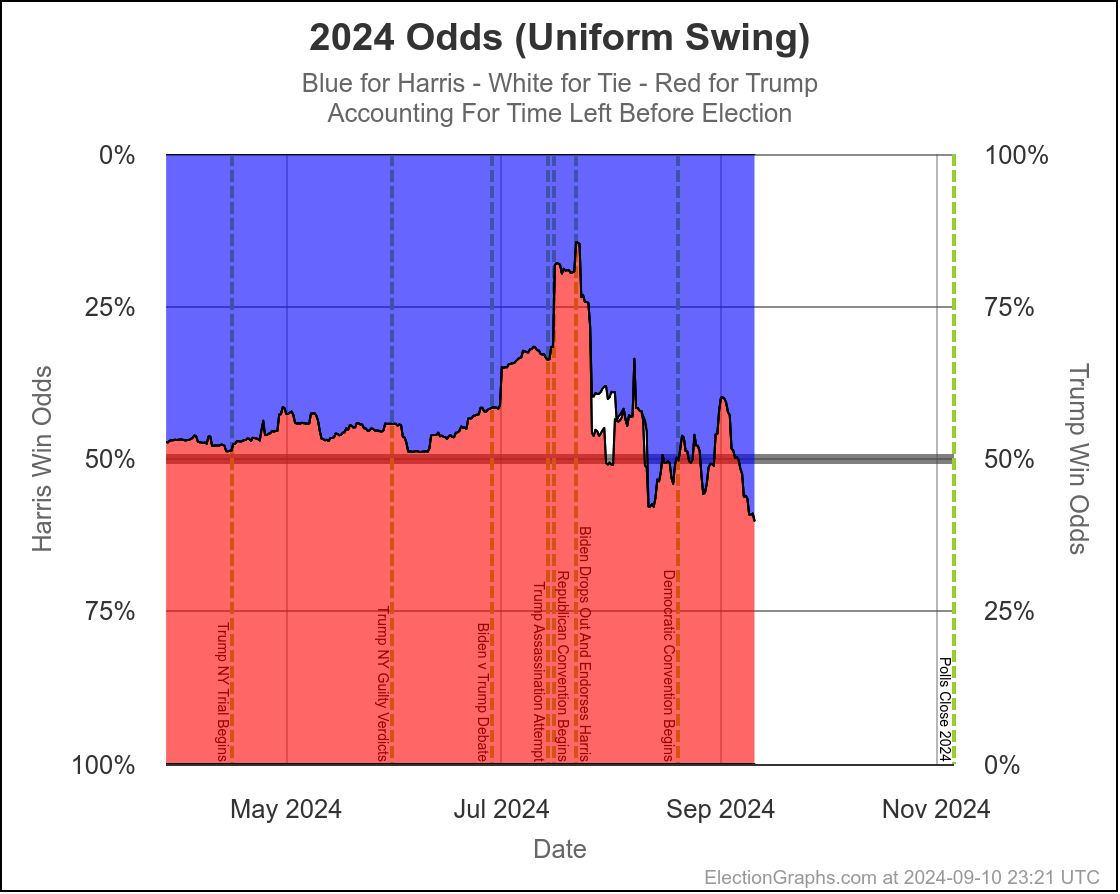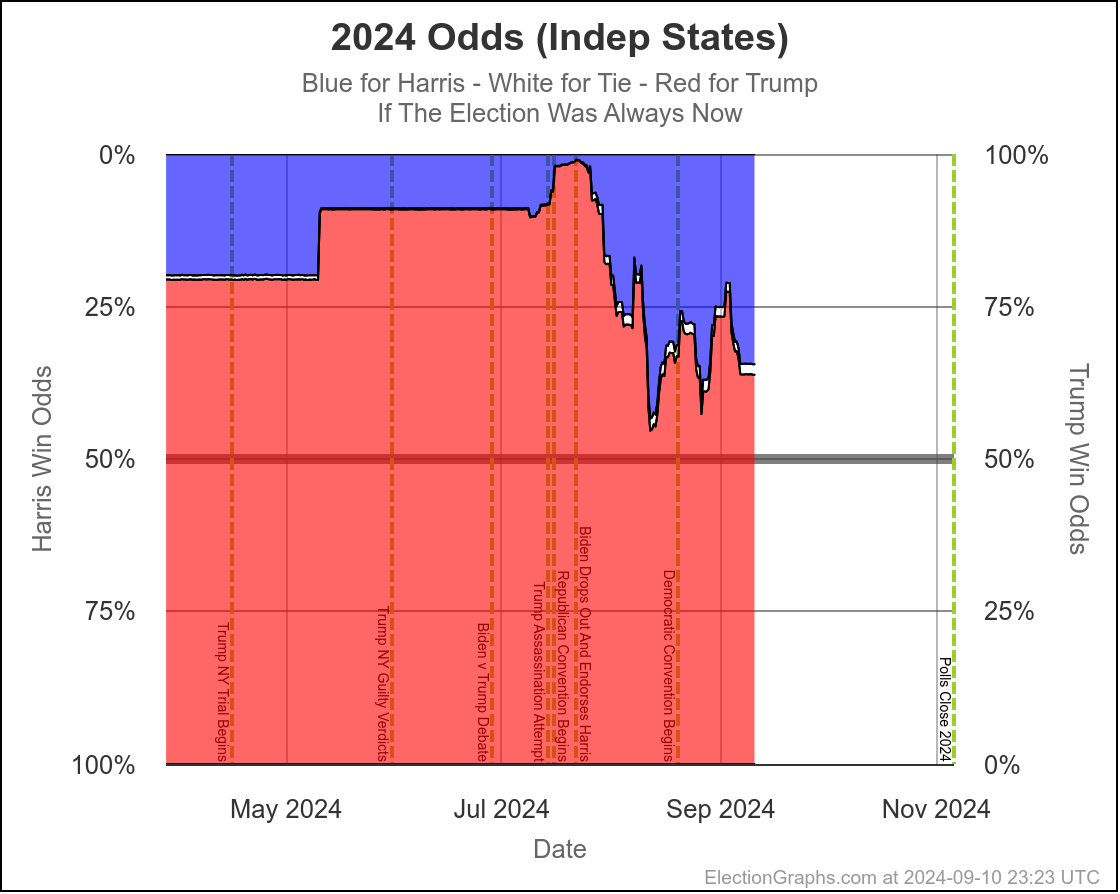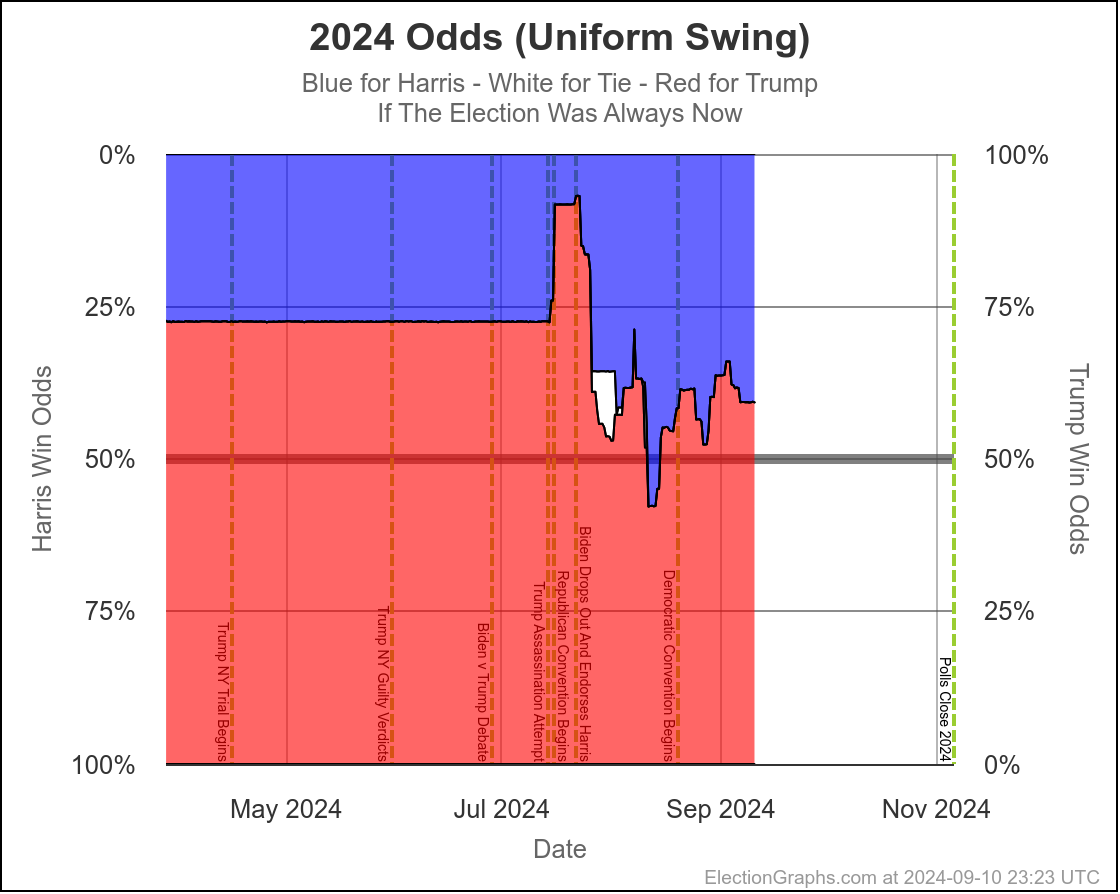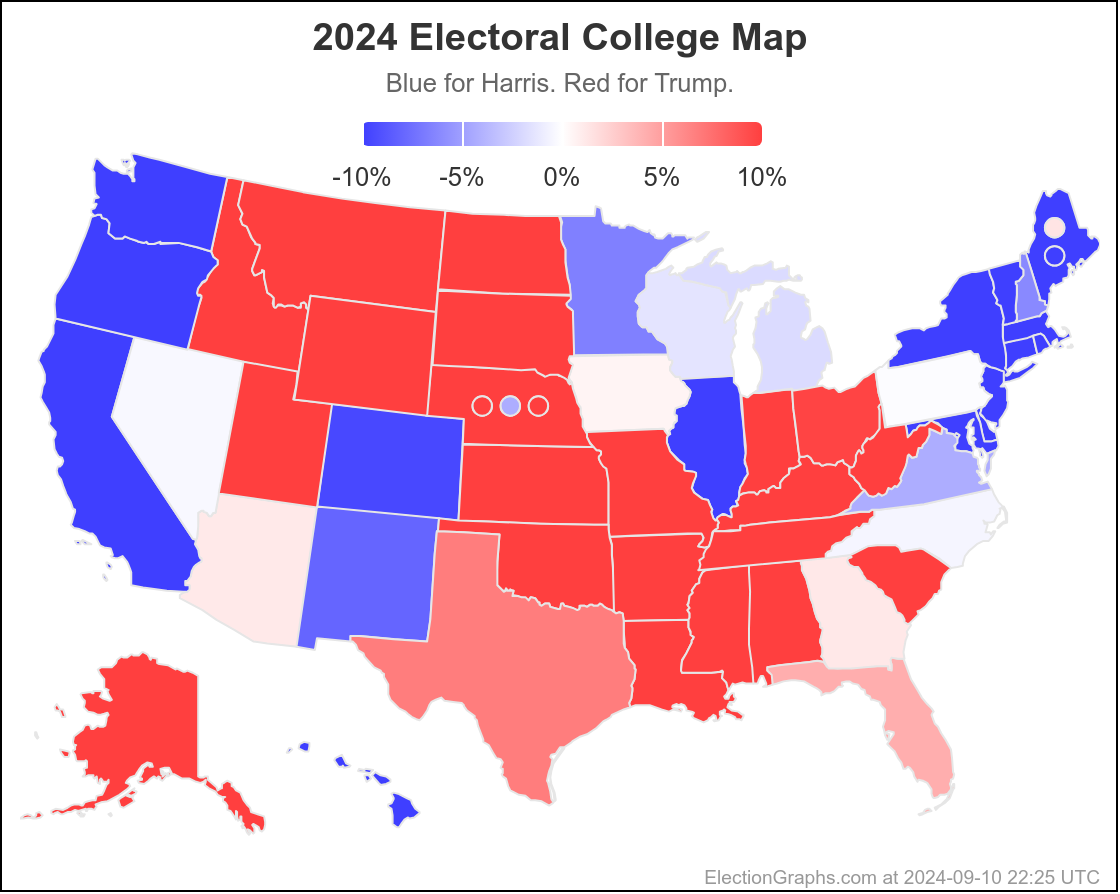It has been 23 days since my last post.
At that time, things had moved from "Trump is heavily favored, but it is still possible for Harris to catch up" when Biden first dropped out, to a toss up situation, but one where Harris had the momentum.
Lets see how the polls have moved since then.
The bottom line for those who don't want to read further, is that while lots of states have moved in Harris's direction, some critical ones have moved toward Trump as well, and so on balance, it is still a toss up.
Now more details for those who want them.
Here's where the close states were back on 2024-08-18:
And now as of 2024-09-10:
The first thing to note is just the massive volume of really close states.
There are a full 144 electoral votes where the margin is under 5%. We have seen multiple examples of states with margins under 5% go to the other candidate in previous elections. Any of these states are legitimately "close" and the candidate that is behind has a non-trivial chance of winning the state.
When this site does "best cases" for both candidates based on just trusting the polls, we consider the possibility that all 144 of these electoral votes could go to one of the candidates. That gives this massive range of possibilities:
Even if you narrow this and only look at places with margins under 2%, you still have 100 electoral votes in play.
Well, Iowa is in here because there have been no polls at all there so we are looking at previous elections to generate the average, and it is probably actually redder than it appears. Take it out and there are still 94 electoral votes in play, and the election could very easily go either way.
So lets compare the before and after on those states and how things changed in the last 23 days:
Movement toward Trump:
- Ohio (17 EV): Trump by 7.1% -> Trump by 9.8% (Trump+2.7%)
- New Mexico (5 EV): Harris by 10.3% -> Harris by 8.0% (Trump+2.3%)
- Arizona (11 EV): Harris by 0.8% -> Trump by 1.1% (Trump+1.9%)
- Wisconsin (10 EV): Harris by 3.2% -> Harris by 1.4% (Trump+1.8%)
- Pennsylvania (19 EV): Harris by 1.9% -> Harris by 0.2% (Trump+1.7%)
- Maine-CD2 (1 EV): Trump by 0.2% -> Trump by 1.4% (Trump+1.2%)
No Movement:
- Iowa (4 EV): Trump by 0.6%
Movement toward Harris:
- Georgia (16 EV): Trump by 1.6% -> Trump by 1.2% (Harris+0.4%)
- Michigan (15 EV): Harris by 1.5% -> Harris by 1.9% (Harris+0.4%)
- Minnesota (10 EV): Harris by 6.2% -> Harris by 6.6% (Harris+0.4%)
- Nevada (6 EV): Trump by 0.7% -> Harris by 0.4% (Harris+1.1%)
- Virginia (13 EV): Harris by 3.2% -> Harris by 4.3% (Harris+1.1%)
- Texas (40 EV): Trump by 8.2% -> Trump by 6.8% (Harris+1.4%)
- Florida (30 EV): Trump by 6.0% -> Trump by 4.2% (Harris+1.8%)
- North Carolina (16 EV): Trump by 1.5% -> Harris by 0.5% (Harris+2.0%)
- New Hampshire (4 EV): Harris by 3.0% -> Harris by 6.1% (Harris+3.1%)
- Colorado (10 EV): Harris by 5.6% -> Harris by 9.5% (Harris+3.9%)
- Nebraska-CD2 (1 EV): Trump by 4.7% -> Harris by 4.3% (Harris+9.0%)
So we have a mixed bag. More states moved toward Harris than moved toward Trump, but some of those states that have moved toward Trump are important.
Here are the charts of the tipping point state at the moment (Nevada) and the two states on either side (ignoring Iowa since there have been no polls there). Really, all of the states under 5% are battleground states, but these five states are currently the center of that battleground, and the ones the race is pivoting around at the moment:
The thing to note is that in all of these key states when looking at the trend (rather than just comparing to the last blog post) it seems like Harris peaked, followed by movement back toward Trump.
As of now, in North Carolina and Arizona a move back toward Harris has started. But things look pretty flat lately in Nevada and Pennsylvania. And it looks like things may still be trending toward Trump in Wisconsin.
All of these are incredibly close states. So to see how this looks in terms of the overall impact on the national race, lets look at the tipping point, which is the margin in the state that would put the winner over the edge:
There have been ups and downs along the way as polls in various close states have jittered, but the high level trend is that Harris peaked at a 1.8% lead in the tipping point, but has since lost ground, and at the moment is at a 0.4% lead in the tipping point.
This is an incredibly narrow lead. Let me add in the comparison lines for 2016 and 2020:
Although there was a moment like it looked like it might happen, so far Harris has never been doing better than Clinton was doing the same number of days before the election, let alone Biden.
So the fact that Harris is narrowly ahead, should not give Democrats a whole lot of confidence. Right now this race is on a knife's edge.
But we can quantify this. Lets look at my probabilistic models for a moment.
First the charts that try to take into account how much time is left before the election, by comparing how far off Election Graphs poll averages at this same amount of time before the election were to the actual election results in 2008, 2012, 2016, and 2020.
I have two models based on the extremes of how correlated the polling errors in the states are. To explain this a bit more:
The Independent States model says that it is perfectly reasonable to think that Harris might do a lot better than expected in Florida at the same time that she does a lot worse than expected in Virginia. The error in one state tells you nothing about the errors in other states.
Meanwhile, the Uniform Swing model says, no, if the polls have been underestimating Trump in one state, they are probably underestimating him everywhere. So you basically only have to worry about the nationwide bias in the polling averages.
The actual truth is somewhere in between, but I don't know where. So I present both models and the range of possibilities they represent.
First thing I'll note, since last time the chances of a 269-269 tie have plummeted. On August 18th I had that as 1.8% to 10.8% depending on the model. I now have the chance of a tie as between 0.0% and 1.6%. Which is probably for the best. A tied electoral college would be a very chaotic scenario.
Since ties would most likely go to Trump given how those are resolved, let's look at Harris odds.
Last time Harris's win chances were between 49.8% and 52.9%. Despite the move toward Trump in the tipping point, this has now increased to between 60.1% and 73.5%.
Why?
Um, I'm honestly not entirely sure. It might take a deep dive into the data that I don't have time to do to really understand fully, but here are three possibilities:
- There is less time left before the election for things to change, so even though the lead is smaller, it is more likely to stick.
- The specific configuration of exactly how far ahead in each state each candidate is means that even though her tipping point is less, there are a lot more "paths to victory" for Harris than before, and the path for Trump is narrower.
- Quite simply historically Democrats being slightly up in early September has correlated with them doing well in November more than being slightly up at the end of October does.
One interesting thing though, is that things look very different in the "if the election was now" view that I have been mostly ignoring since I introduced the models that take into account the remaining time:
Here Harris's odds are only 34.5% to 40.7%. This is much lower.
Explaining this is easier. Basically, on average for the last four election cycles the FINAL Election Graphs averages in close states have underestimated the Republican a bit. So in states where the Democrat has a lead, but a very narrow lead there at the very end, the models still give the Republican a very good chance of wining. In a 50/50 situation the Republican is favored a bit.
Now, we won't know until after Election Day if the poll averages once again underestimate the Republican, or if this time they underestimate the Democrat.
But IF polls are underestimating the Republican again, the difference between the "if the election was now" and "with 56 days left" models essentially means that if Harris still had these same numbers on Election Day, Trump would be favored, but right now she still has plenty of time to improve the situation further, so her odds right now are higher. To feel good about the election, Harris needs to further improve her numbers as Election Day approaches. Where she is right now isn't "good enough".
And there we have it. Lets close it out with the current map:
As I type this, there have been about a dozen new state level polls since I started this blog post. They would have changed some of the data here a bit, but I have to make a cutoff somewhere when I make one of these posts, and as we approach the election, the number of polls per day is increasing dramatically. So things change every day. Multiple times a day in fact.
So don't wait for these blog posts. Check out electiongraphs.com regularly in between posts. Or follow us on Mastodon.
For now though, the Harris vs Trump debate starts in less than an hour, and I'm going to be watching it. We'll see in a week or two if it makes any difference. Debates usually don't. But the last one sure did!
56.0 days until the polls in the first states start closing on Election Day.
It will be a wild ride!


